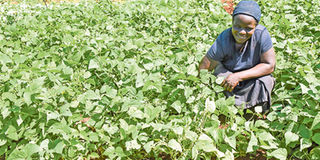Agronomist notebook: Beans are hardy, but look out for rust this rainy season

Jane Kerubo showcases the new variety of beans at the Kenya Agricultural and Livestock Research Organisation (Kalro) demonstration farm at the Moi Showground in Kakamega in 2019. Beans do best in ridges or furrows. However, the spacing should be observed. PHOTO | FILE | NATION MEDIA GROUP
What you need to know:
- This disease usually spreads very fast and must be controlled quickly to avoid severe cases that result in the death of the plant.
- Crop rotation with plants that are not highly infected like broccoli and cauliflower also helps in breaking the disease’s life cycle.
- The seeds should not be deep-planted, especially in wet soils, as this leads to rooting. Excess watering results in damping-off fungal diseases, which kill the young plants.
- Cutworms are brown or black and are usually found in the soil. All the plant debris should be removed as this acts as a hiding place for the worms.
Beans are one of the major crops grown in the country both for subsistence and commercial purposes. In most regions, it is intercropped with maize.
Beans take about three months to mature, depending on the variety, and they are a stress-free crop because they are largely not affected by pests and diseases.
Last week I met Irene, a farmer in Machakos who has been planting beans as a pure stand on her farm. She said she had chosen the crop because it is less labour-intensive and fetches good prices.
But she was a worried farmer because her crops were affected by rust, a fungal disease that is caused by Uromyces appendiculatus. The disease affects leaves, stems and pods.
It is most prevalent during the rainy season when the humidity is very high and is characterised by the presence of raised, small white spots on the lower leaf surface, which turn red to dark brown after a few days.
Infected pods develop red-brown powdery pustules surrounded by a yellow halo. This makes the pods deformed. However, most symptoms are usually on the lower side of the leaf.
This disease usually spreads very fast and must be controlled quickly to avoid severe cases that result in the death of the plant.
Disease spores can easily be carried by wind, tools and equipment while carrying out routine management practices.
To minimise instances of the disease spreading, a border crop can be planted to act as a windbreaker.
Also, ensure all the tools are disinfected and work from the unaffected to the affected areas to avoid further spread of the disease.
Crop rotation with plants that are not highly infected like broccoli and cauliflower also helps in breaking the disease’s life cycle.
Since the leguminous crops fix nitrogen, it is recommended to rotate them with brassicas since they require nitrogen for vegetative growth and are not affected by rust.
LEACHING OF NUTRIENTS
While planting at a spacing of 15 by 30cm, it is also important to grow varieties that are tolerant or resistant to rust diseases.
The seeds should not be deep-planted, especially in wet soils, as this leads to rooting. Excess watering results in damping-off fungal diseases, which kill the young plants.
This also makes the plants to turn yellow due to leaching of nutrients. Also, control against cutworms as they cut the seedlings at the base of the plant, resulting in seedlings drying off.
Cutworms are brown or black and are usually found in the soil. All the plant debris should be removed as this acts as a hiding place for the worms.
Chemicals can be used to prevent and control diseases and pests to avoid further spread. Other pests that affect beans include beetles, aphids and mites.
Farmers should avoid planting beans where nitrogen content in the soil is high since the crop has rhizobium, which helps in fixing the mineral in the soil. Excess nitrogen results in the plants being vegetative with few pods.
Timely weeding is critical as this reduces competition for nutrients, light and space. Regular water supply is necessary and is more critical during flowering to avoid flower abortion.
However, avoid excess watering to curb waterlogging, which causes the beans to turn yellow due to leaching of nutrients.
Beans do best in ridges or furrows. However, the spacing should be observed. After harvesting, thresh, dry and store in well-ventilated place for a longer shelf-life.
Market for beans is overwhelming as they are a reliable source of proteins. Depending on the variety, location and season, a 90kg bag of beans ranges from Sh6,000 to Sh12,000.





